Fermented horseradish is a delicious way to preserve horseradish, increase its benefits and use it in your daily diet. 3 horseradish recipes.
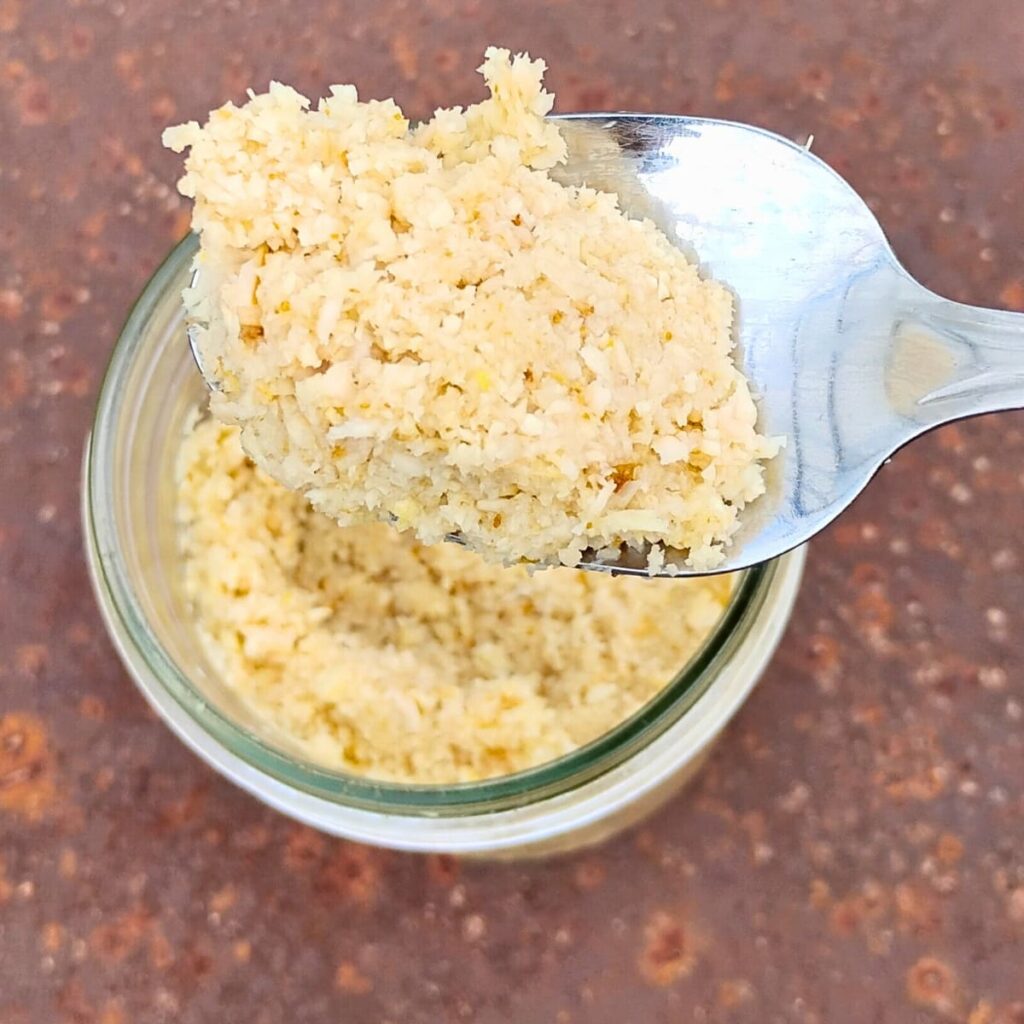
This post contains Amazon and other affiliate links, which means I make a small commission at no extra cost to you if you click through and make a purchase. See my full disclosure here.
Horseradish root is such a delicious condiment for meats and fish and it adds a bit of spiciness to dips and dressings. But it also has many health benefits too. I decided to ferment some horseradish root to keep it on hand in my refrigerator so I can get a daily dose, and it tastes great right out of the jar.
Fermenting adds even more benefits and it reduces the pungency of the horseradish while keeping the flavor, so it’s really easy to eat by the spoonful. Learn how to grow horseradish and discover the benefits of horseradish next and then you’ll find both the fermented and vinegar-prepared horseradish root recipes and a horseradish extract recipe. Let’s learn more about horseradish!
If you like fermented or prepared horseradish for convenience, you might be interested in my ‘convenience garlic’, a fermented garlic paste that keeps for years in your refrigerator and tastes awesome when aged. And try some fermented chili paste, ginger paste, or turmeric paste for a handy seasoning and for the health benefits. One of my favorite seasonings is fermented lemon paste. It’s so great to have this on hand any time I need some lemon for baking or cooking.
- All About Fermented Horseradish Root
All About Fermented Horseradish Root
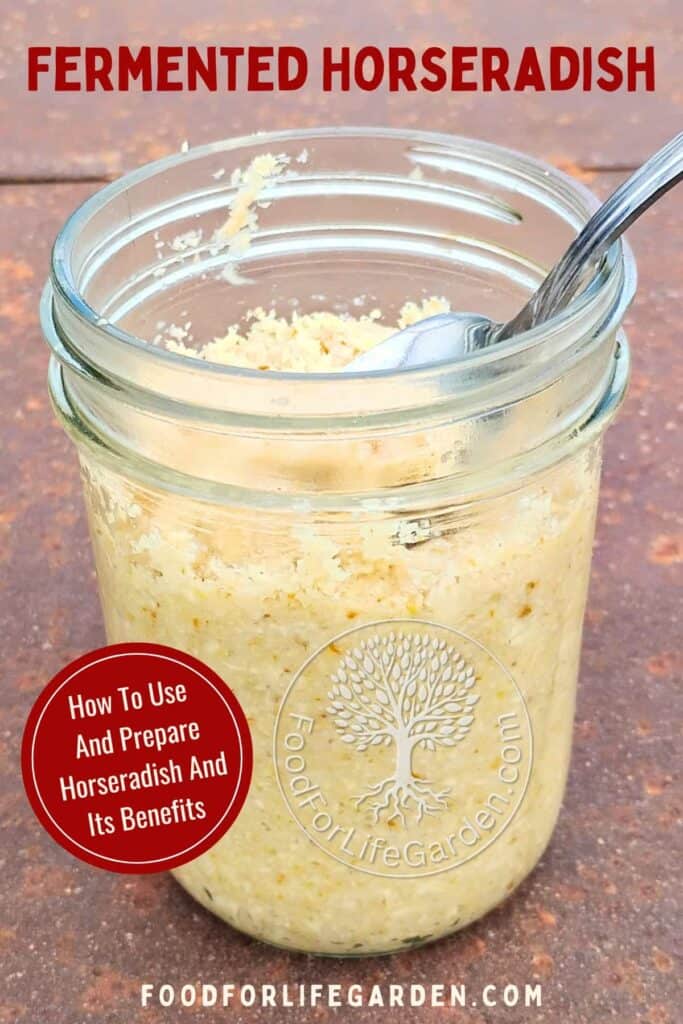
The horseradish root and greens are all edible. They are both pungent and when you smell them, you’ll know you’ve got horseradish. Horseradish (Armoracia rusticana) is in the brassica family, which includes cabbage, broccoli, radishes, mustards, and many more.
Unlike most of the cabbages and mustards, horseradish is a perennial plant and will grow back year after year. It is propagated by root cuttings. These are fairly easy to find. You can probably get them in your grocery store.
It is possible that the roots you get from the grocery store have been treated to prevent sprouting and prolong storage. If that’s the case, they may not sprout for you, so your best bet is to start with organic root cuttings.
Horseradish is easy to grow and can become a bit invasive if you let it ramble. To harvest, wait a couple of years and then dig up the root in the fall or winter, use what you need and place the rest back in the ground. This way you can add more horseradish patches. But even without trying, it’s likely you’ll have it for life once it’s established.
Best time to harvest is after the first frost in the fall, and throughout winter up until very early spring, before it breaks dormancy. At this point the plant will put its energy into growing leaves and the root will loose its potency.
Store any harvested roots in a paperbag in the refrigerator. They are good for a couple of months usually.
The Benefits Of Horseradish
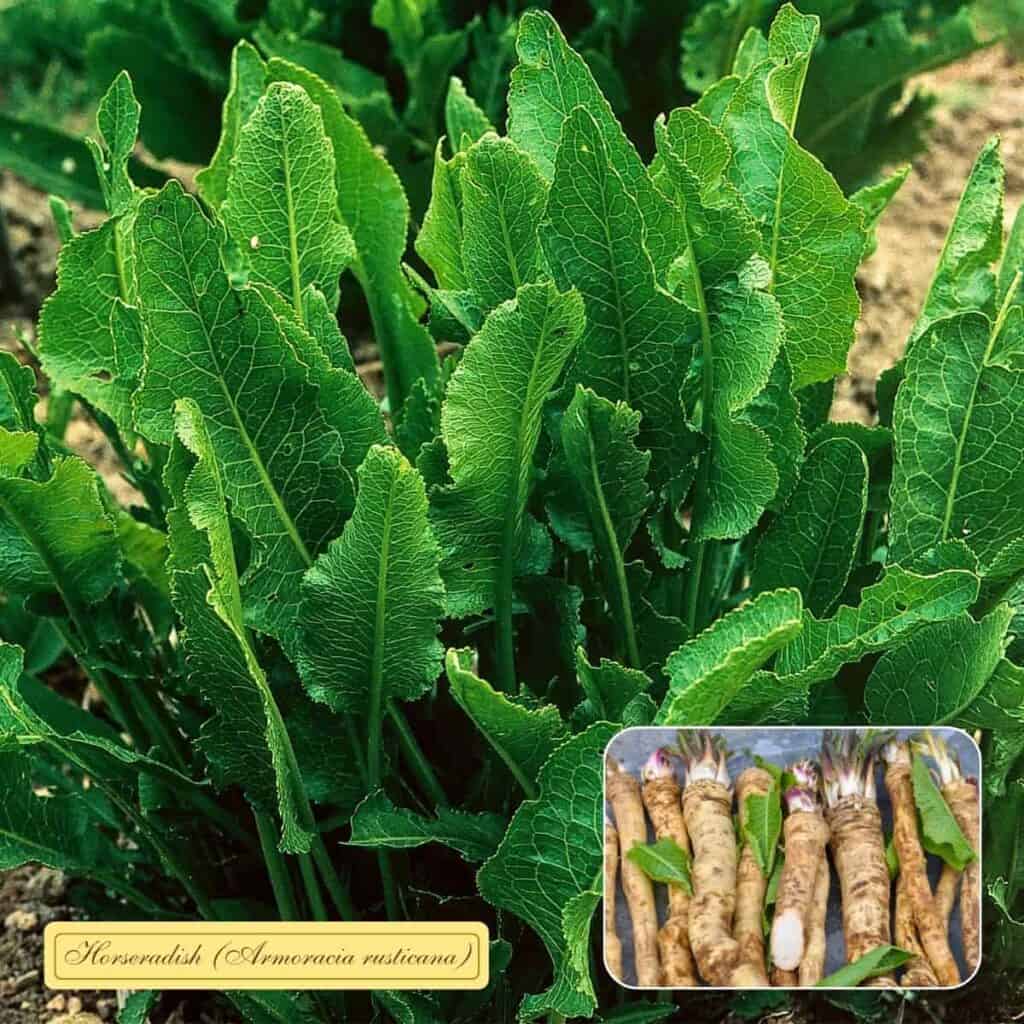
Horseradish has quite a reputation for its pungency. This is caused by allyl isothiocyanate, which is activated when we cut into the horseradish. Anyone who’s grated horseradish before will most likely remember what it was like. I know I do. When I grated about a pint of horseradish, I cried me a river and had to do it with my eyes closed. The fumes were just so strong. It’s like cutting spicy onions, but way worse.
I could not find much information specific to the leaves of the horseradish. But they are edible. They taste pungent and can be bitter. So if you are not into bold flavors, it’s probably best to mix just a small percentage of horseradish leaves with some not so bitter greens. But they appear to have the same benefits as the roots.
They are much like mustard greens. If you like mustard greens you’ll probably like horseradish greens. If you give preference to the young tender greens from the center, the taste will be more delicate. Discard the tough midribs before cooking the leaves.
Horseradish has been used medicinally throughout the ages in most cultures. It was known by the indigenous peoples of South America, Europeans, Japanese people, and many others.
Let’s learn about the great benefits of horseradish, which have even caught the attention of modern science recently.
High In Nutrients
Horseradish root contains essential nutrients and is a good source of Calcium, Magnesium, Potassium, Phosphorous, Folates, Vitamin C, Zinc, and Carbohydrates
Horseradish leaves contain potassium, magnesium, vitamin C, and calcium. They also contain glucosinolates, which are enzymes that give the leaves and root their spicy flavor.
Immune Support
Horseradish compounds have been found to support the immune system, inhibit inflammation, and help fight colds and infections.
Respiratory Aid
The allyl isothiocyanate compound that causes irritation in the sinuses is super beneficial for respiratory complaints. It will help increase facial blood circulation, reduce inflammation, promote drainage, and clear the sinuses. Allyl isothiocyanate can create excess mucus temporarily, which can be very beneficial in clearing an infection and flushing out the undesirable bacteria in your sinuses. It might also speed healing of coughs and the common cold.
If you’re trying to reduce use of antibiotics, and I think we all should whenever possible, consider horseradish to help heal bronchitis and sinusitis. A German study has shown that it was just as effective as antibiotics in treating these bacterial infections and without the side effects or the danger of antibiotic resistance and allergic reactions.
Take a bit of fresh grated horseradish root and keep it in your mouth. It will fumigate your sinuses with a burning sensation and make you cry while improving your sinus infection and draining your mucus. Great stuff!
Diuretic Properties
Horseradish can promote urination and detoxification. The glycoside sinigrin in horseradish might help prevent kidney and urinary tract infections, as well as water retention.
And according to Dr. Axe it can help treat acute urinary tract infections better than conventional antibiotic treatments, which usually involve a number of unpleasant side effects.
Antibacterial And Antifungal Properties
A phytochemical compound in horseradish, allyl isothiocyanate, has antibacterial and anti-fungal properties, which can possibly help with food poisoning, stomach ulcers, and skin and nail fungus.
This same compound might also help fight bacteria like E. coli, salmonella and H. pylori. Allyl isothiocyanate (AITC) has been found an effective antimicrobial against a wide spectrum of pathogens.
AITC has even found use in treatment of packaging material as an antibacterial agent.
Anti-inflammatory And Pain Relief
A chemical compound in horseradish, sinigrin, can lower inflammation by disrupting the body’s inflammatory response before it flares up. This can possibly help prevent hardening of the arteries. And, applied topically, it can help with the inflammation and pain associated with arthritis.
Inflammation has been shown to cause diseases such as Alzheimer’s, cancer, diabetes, hearth disease and arthritis. So reducing or preventing chronic inflammation is very important for overall health.
Horseradish has also been used in traditional medicine, to reduce pain and inflammation associated with headaches, and back pain.
Helps With Digestion
Horseradish can improve liver function. It is part of a group called cholagogues, which trigger the gallbladder to release bile, which is an important part of the digestive process. Bile can help get rid of excess cholesterol, fats, and other wastes.
A healthy digestive system is so important for overall health and horseradish can be your ally here. Horseradish might also help prevent bloating and gas. It has been used to stimulate digestion, regulate bowel movements and relieve constipation.
Horseradish is high in fiber. Increasing your fiber intake can help with conditions like GERD, diverticulitis and stomach ulcers.
Antioxidant and Anti-Cancer Properties
High in antioxidant compounds such as glucosinolates, horseradish can help fight cell damage caused by free radicals. These compounds attach themselves to the free radicals, which neutralizes them. Impressively, horseradish contains 10 times more glucosinolates than broccoli!
These powerful compounds can help protect against cancer, infections and brain disease. According to some recent preliminary studies, they can inhibit the growth of cancer cells and promote their death! They have been found to help with colon, lung, liver, and stomach cancer.
Eating horseradish regularly can help make the body more resistant to cancer.
These antioxidants can also help stimulate white blood cell activity, which is important for a stronger immune system. Some of these antioxidants are antimutagenic and can protect the body from mutations, which have been blamed for heart disease and other common degenerative disorders.
Weight Loss
Replace some of your high sugar and high calorie condiments such as ketchup, mayonnaise, ranch dressing and BBQ sauce, with a serving of fermented or prepared horseradish. It is low in calories, high in fiber, adds lots of flavor, and the pungent allyl isothiocyanate can rev up your metabolism.
Cautions:
There is limited information about possible side effects or the effects of consuming too much such as in the form of supplements. The mustard oil in horseradish can be very irritating to some people, and it will cause burning in the nasal passages. Fermenting reduces this problem.
Young children should not be given fresh horseradish and it is unknown if it is safe for pregnant or nursing women. If you’re taking medication or suffering with a disease, are pregnant or nursing, be sure to consult with your doctor or naturopath before taking horseradish.
Those with ulcers, inflammatory bowel disease, and under-active thyroid glands should consult with their health practitioner before consuming horseradish, as it may irritate conditions.
As always, when introducing any new foods, it is always best to start with small amounts and observe for side effects or allergic reactions.
Disclaimer
I am not a doctor or claim to be qualified in any way to give medical advice. I am self-taught and this article reflects just my opinions, experiences with herbs, and what I’ve learned from research and years of studying herbalism, herbs and their uses. It is meant as an entertaining source for ideas and reference, and to encourage interest in herbalism. It is my hope to help you get to know and appreciate herbs and their traditional uses. Please do not use any of this information to replace professional advice!
Sources
Dennis Horseradish, Healthline, Dr. Axe, WebMd, Relish, Cleveland Clinic, Medicine Net, NIH, and NIH
Benefits of Fermented Horseradish Root
While Fermenting cuts the pungency, it can increase the actions of isothiocyanate compounds. I don’t think that it would work well for increasing your mucus or draining your congestion, because that part relies on the pungency of the compound, and so for relieving sinus infections and other respiratory illnesses I would use the fresh horseradish, or make a horseradish tincture (recipe below). However, for daily use, which is what I am using it for, the fermented version has some excellent benefits without being overly pungent. I can eat it by the spoonful and it’s really tasty without making me cry.
Fermenting in general will increase the compounds and bioavailability of vitamins and minerals in foods. This means, fermenting will increase the vitamin C and other nutrients, which will also increase its antioxidant properties. And it will also help the body to absorb all these nutrients better than it would without fermentation.
Fermentation also introduces probiotics. All the vegetables contain different strains of probiotic microbes. So eating a variety of fermented foods can be super beneficial for your health in countless ways.
In the case of horseradish, I like to take it for its anti-inflammatory, heart- and liver-supporting, and anti-cancer properties. I eat a few spoonfuls throughout the day. It’s a tasty snack!
There is one study I found, which specifically researched fermenting horseradish, that suggests that fermenting increases the content of health-promoting ITC compounds (such as allyl isothiocyanate) (source)
Lacto-Fermented vs. Vinegar Prepared Horseradish
I like to have both on hand, the vinegar based prepared horseradish, which I can use right away, and the fermented horseradish, which is easier to eat on a daily basis, but takes longer to make. Fermenting makes the benficial compounds in horseradish more bioavailable and adds probiotics for a healthy gut.
I like to use the freshly made vinegar based preparation for colds and flus, to get the benefit of the hot mustard oils fumigating my passages, relieving congestion, and flushing out the unhealthy bacteria. In addition, Apple cider vinegar has its own set of benefits to support the immune system and more. You can read about that in my homemade apple cider vinegar post.
Other Horseradish Preparations
Another way I like to take horseradish is in fire cider. This is another great preparation for cold and flu support.
To preserve the pungency of the horseradish for the longer term, I make a tincture, which I can store in my pantry for sinus infections, when fresh horseradish might not be available. I’ll provide the recipe below.
How to Ferment Horseradish Root
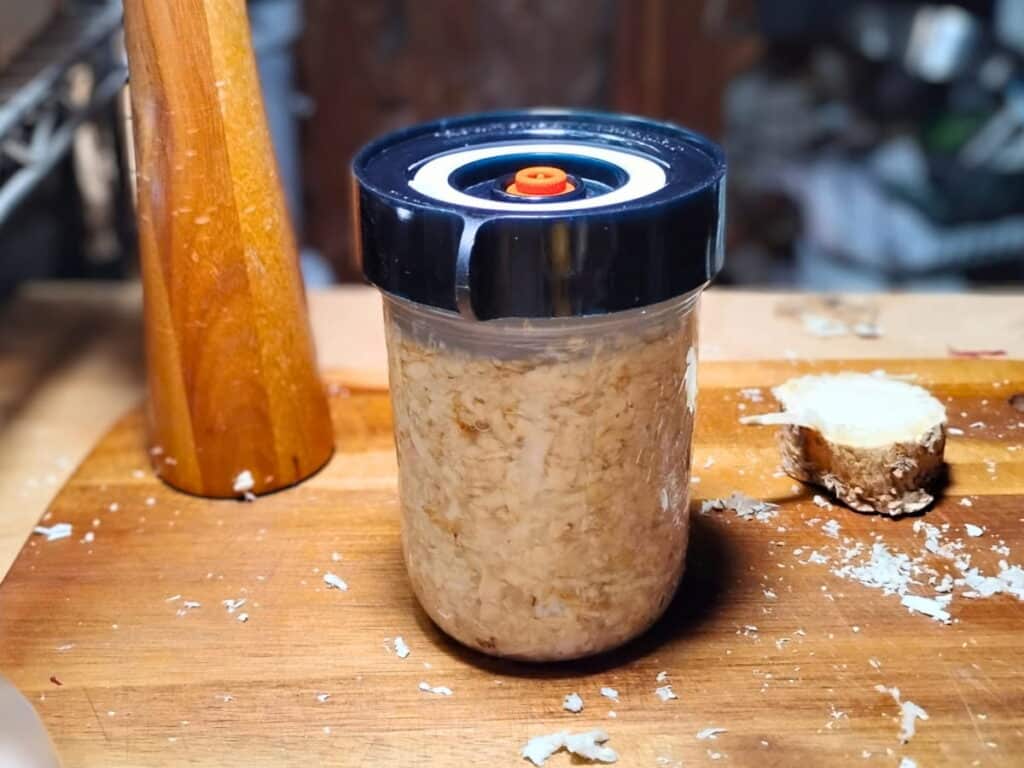
Equipment:
A pint jar for fermenting – My favorite vessels for fermenting are plain wide mouth mason jars or the beautiful and very functional Bormioli Fido Jars.
Fermentation lid – Fermentation lids or Airlocks are is a super helpful tools to keep fermenting low maintenance when you use canning jars. But they are not required and you can totally use a regular canning jar lid. Just remember to burp it every day.
Fermentation weight – A glass fermentation weight is another super helpful tool for fermenting that I highly recommend. You’ll use it to keep all the ingredients submerged under the brine, and to prevent mold and other undesirable bacteria from ruining your fermentation.
Alternatively, you can use a boiled rock, a baggie filled with marbles or salt brine, or you can just stir it every day (I found this the least reliable method). They all work, but present some hassles and can be awkward.
Pickle packer – I recommend a Acacia wood pickle packer if you’ll be fermenting regularly. It’s a great tool to use for packing your salt ferments, but you can use your fist as well.
Scale – optional – I like using a scale mostly for the sake of easy scalability. This way, I can just weigh my ingredients, add the correct amount of salt, no matter how much ingredients I have, and don’t have to think too hard.
Blender, Grater or Food Processor – What you use depends mostly on how you prefer your finished paste consistency. An electric food processor or Manual chopper will chop it more or less fine.
You can use a fine or coarse grater too, but it can be brutal on the sinuses. And if you want a quantity of a fairly smooth paste, you’ll might want to reach for your Blender or Vitamix. You can add a bit of water to make it easier to blend.
Wide mouth funnel – If you’ve done any canning or fermenting, or if you work with herbs, you’ll most likely have a wide mouth funnel to get ingredients into the jars without making too much of a mess, or spilling your precious ingredients. Another very useful optional item.
Ingredients:
I recommend you use all organic ingredients. Let’s try to reduce the amount of toxins and harmful chemicals that we put in our bodies. That is so important for keeping or improving our health!
Organic Horseradish root – I used about 14 ounces to get just under 2 cups of grated horseradish. I don’t peel mine, but you can. However, you’ll remove the beneficial bacteria that resides on the skin, which will help you get a good fermentation.
If you do remove the skin, add a few tablespoons of starter, which can be the liquid of a previously completed ferment or active whey. Likewise, if your horseradish root is not organic, it’s a good idea to add starter culture as well, since most often any beneficial bacteria on the skin has been destroyed with chemical treatments.
Salt – My recommendation is to use Redmond’s Real Salt or Himalayan pink salt. You can also use unrefined sea salt. Do not use anything that has additives! And the best salt is unrefined salt.
Raw Apple Cider Vinegar – We’ll use just a small amount after fermentation is completed for the lacto-fermented horseradish root. It will add flavor, and it will help to keep the ingredients submerged, especially if they dry up during fermentation. I used my homemade apple cider vinegar.
Instructions:
Prepare The Horseradish Root
While peeling improves the texture of horseradish, it’s better to leave it on when you ferment it. We want the nutrients in the skin and the beneficial bacteria that grows naturally on the skin for a better fermentation. If you want to peel yours, or if you can’t locate organic horseradish root, it’s best to add a few tablespoons of starter culture. This can be the juice from a previous ferment or whey from cheesemaking.
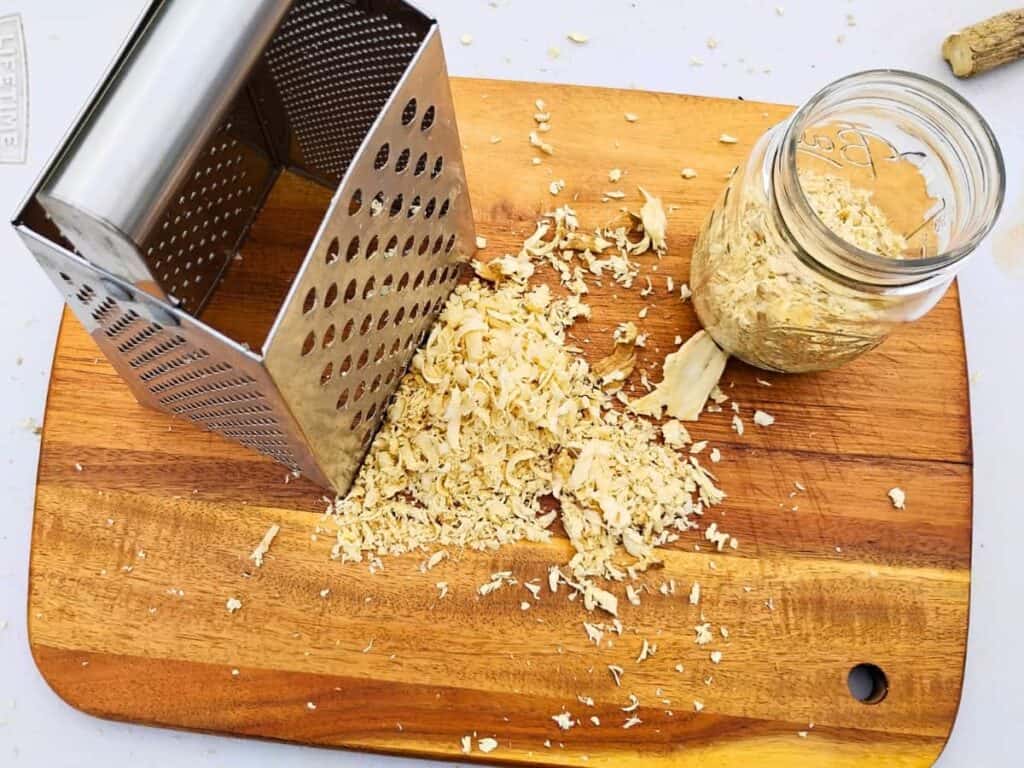
Grate your horseradish on the fine side of your grater. Mine came out too coarse as you can see. Or you can roughly chop the horseradish and use a food processor to chop it. I advise doing so outside where the fumes won’t irritate your sinuses or eyes.
Add Salt

Now calculate your salt. You’ll be using 2% of the weight of the horseradish in salt. If your horseradish weighs 400 grams, this is your formula: 400 x .02 = 8. You’ll be adding 8 grams of salt. If you don’t have a scale, add 1½ tsp of salt per pint of horseradish.
Give the paste another whirl in your processor or stir well to incorporate the salt.
Pack The Grated Horseradish Into A Jar
Using a funnel, transfer your ingredients into the fermentation jar.
With your pickle packer or your fist, press the ingredients firmly into the jar to eliminate air bubbles and to coax out some brine so your ingredients are submerged. If you don’t have enough brine to cover the horseradish, you can add a little water.
Add A Weight
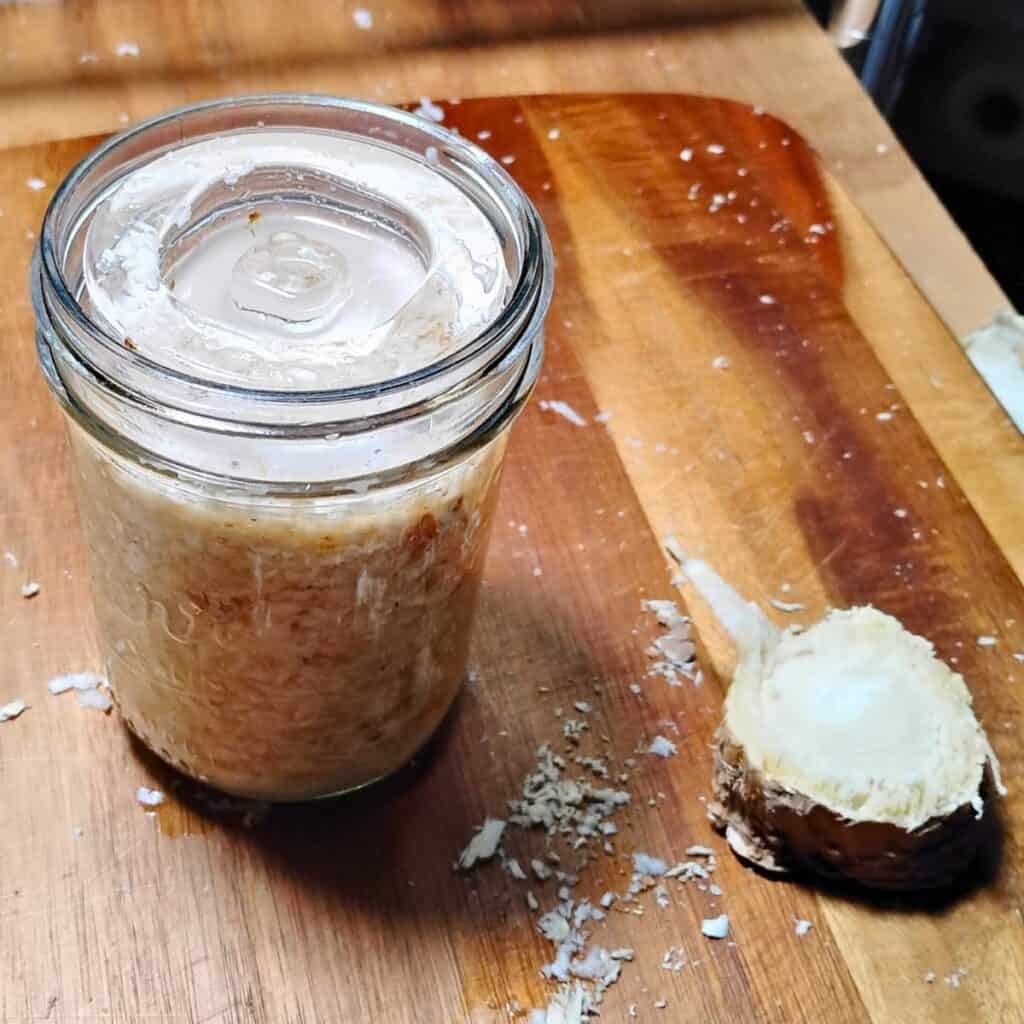
Add a weight to keep the ingredients submerged during fermentation.
Cover And Ferment

Seal with a fermentation lid. If you’re using an ordinary canning jar lid, you’ll need to be sure to burp it every day.
Place a plate under it and leave it for 1-3 weeks in a darkish corner at about 70-80℉. 3 weeks is the recommended time for full long fermentation. But it will be pretty good after a week.
Maintenance: Just keep a casual eye on your fermentation. You don’t need to do anything if it looks ok. It will start to bubble and possibly ooze out of the jar after a few days. That is a good sign.
Important: If you’re using a regular mason jar lid, don’t forget to burp it every day.
Storing Your Fermented Horseradish Root
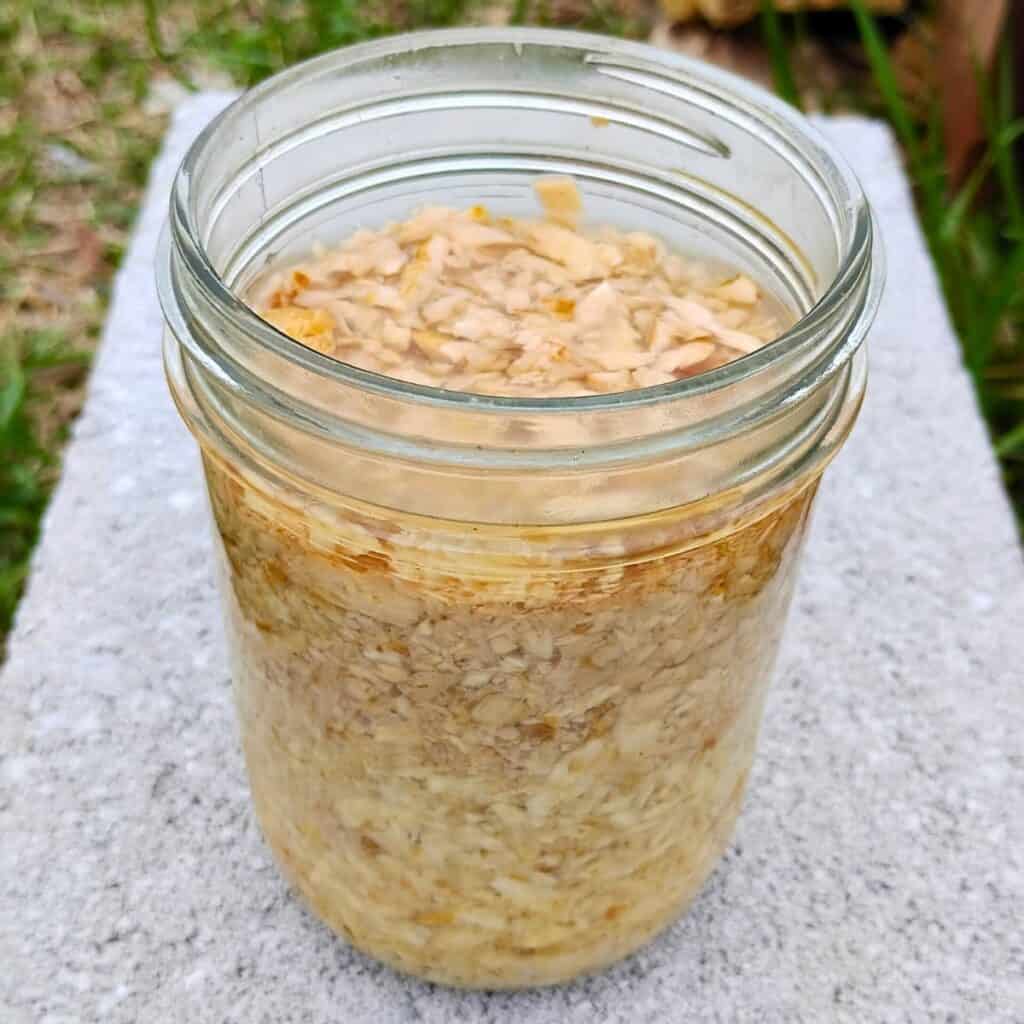
After a week, you can open it, look at it, smell it. If nothing seems off, taste some. If it’s good, and you want to store it, take out the weight and add the two tablespoons of vinegar or enough to keep the horseradish covered. Otherwise let it ferment a couple more weeks.
Top with a regular lid and place into the refrigerator or a root cellar. There it will keep for at least a year.
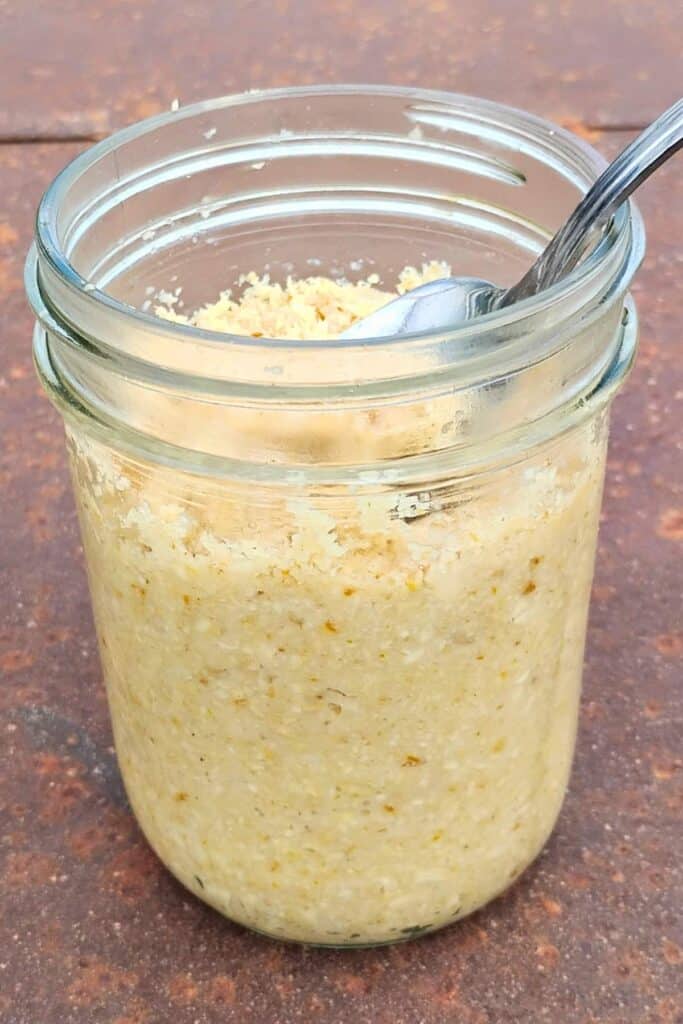
I ended up blending mine a little more fine after it was done fermenting, since my horseradish was very coarse. Now it’s more like a paste.
How To Make Prepared Horseradish With Vinegar
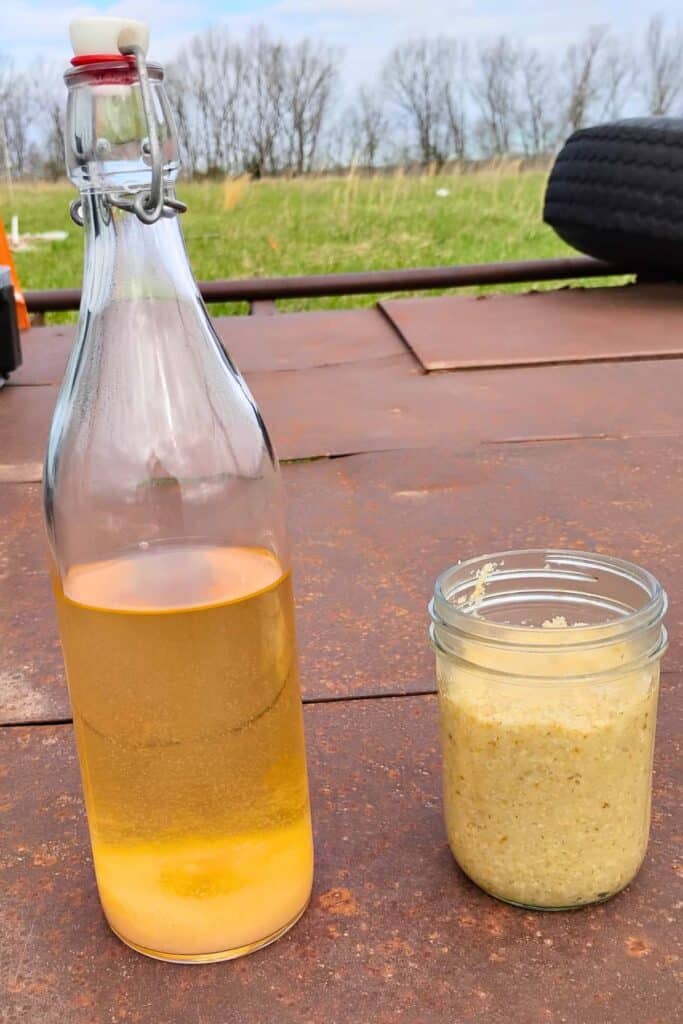
Ingredients:
Horseradish – You can peel it if you like, we don’t need the bacteria from the horseradish skin this time. Grate or process it in a food processor.
Salt – I recommend an unrefined sea salt with no additives, such as Redmond real salt or Himalayan salt..
Raw vinegar – Use an Apple cider vinegar “with the mother”. I used my delicious homemade apple cider vinegar.
Instructions
If you want to make a quick prepared horse radish, it will still be probiotic if you use this method, but the probiotics will come from the raw vinegar instead. In this preparation you can peel the horseradish if you prefer, because we don’t rely on the bacteria to help with the ferment.
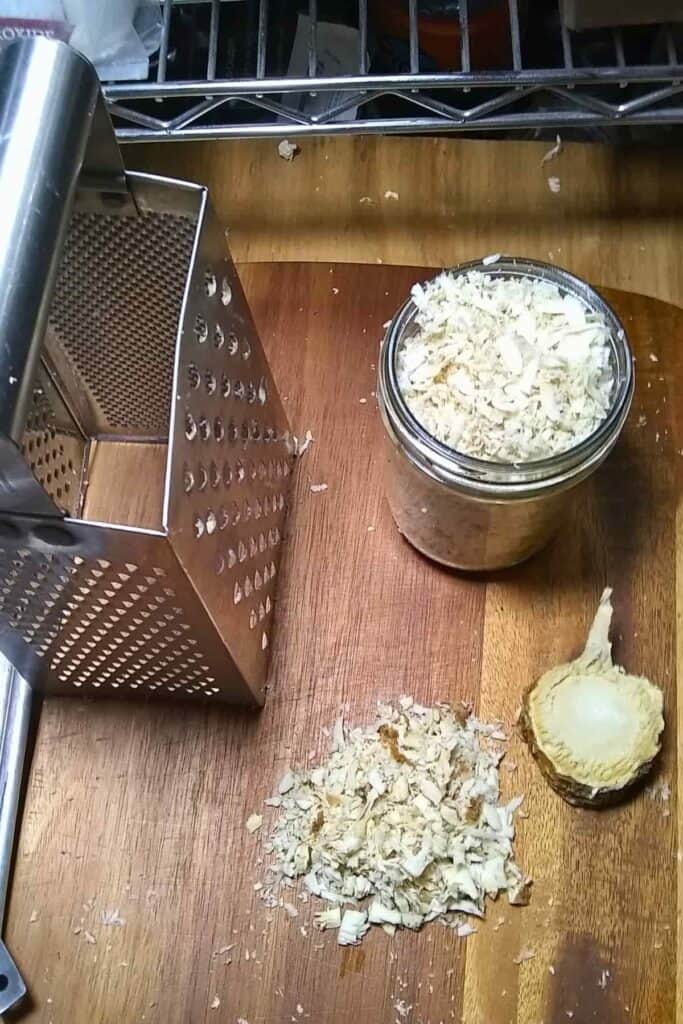
- Prepare the horseradish by washing and if you prefer, you can peel it. Then grate or process it in a food processor.
- Let the horseradish stand for about 3-5 minutes to develop it’s pungency before adding the vinegar.
- Mix well with the salt, add it to a jar and pour vinegar over it to cover. I like to keep it out at room temperature for a few days, and then put it into the refrigerator, where it should keep for several months.
You can use this immediately if you like, and this is when it has it’s greatest pungency. After you store it in the refrigerator for several months, the pungency will decline over time, but it will still be a tasty seasoning to add to your favorite dishes.
How To Use Prepared Or Fermented Horseradish Root
- You can treat this paste as a seasoning for any dishes that you like to spice up a little. But here are a few ideas for specific uses:
- Make a Cocktail Shrimp sauce
- Use it to flavor a Bloody or Virgin Mary
- Replace your not so healthy toppings with this healthy one in burgers, sandwiches, BBQ meats, etc.
- Use it in a creamy sauce made with sour cream, mayonnaise, or cream cheese as a condiment for your prime rib, lamb roast or fish.
- Top your baked potato with it.
- Add it to potato salad, macaroni salad, egg salad, grated carrot and celery root salad, mashed potato and deviled eggs.
- Add it to your hummus or aioli.
How To Make Horseradish Extract

- If you want some horseradish on hand for relieving sinusitis or a stuffy nose, you can preserve its pungency inside a tincture.
- All you need to do is fill a jar loosely, half full, with grated or thinly sliced horseradish root. Let it sit for 3-5 minutes to develop its pungency.
- Then pour 100 proof vodka over it (80 proof will do in a pinch). Fill the jar to the very top and seal.
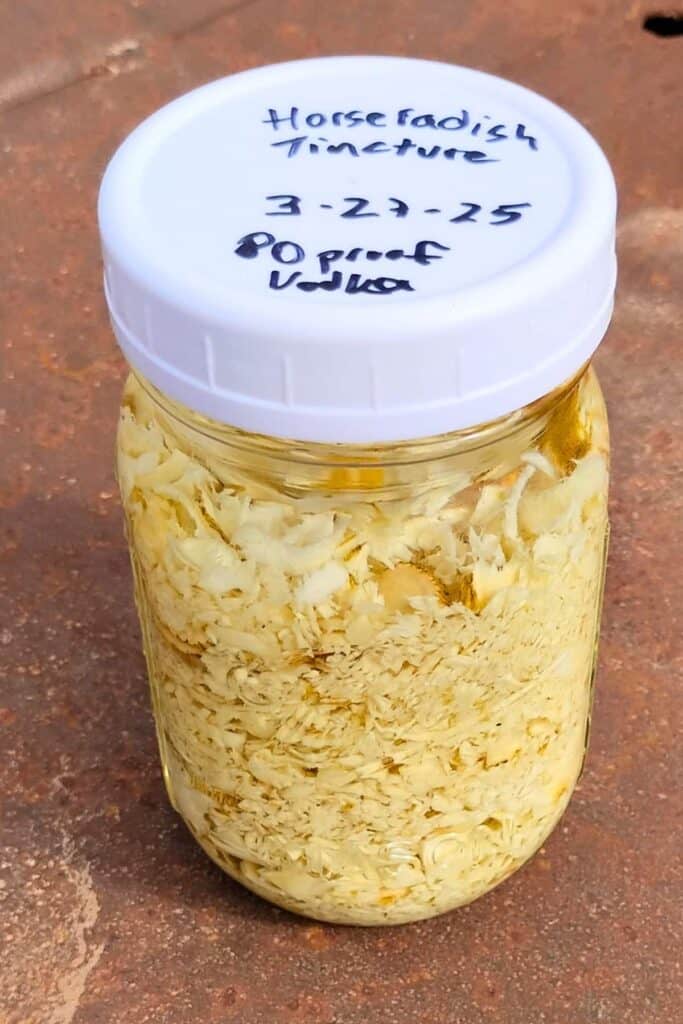
- Shake it every day or two and let it extract for 6 weeks or longer if you’re busy.
- Now strain out the herb through a piece of cotton cloth or butter muslin, squeezing as much liquid out as you can. Cap it tightly and store for when you need it.
- You can fill a small amount into dropper bottles so it is easy to dose. But don’t store it in the dropper bottles for more than a few months. The alcohol can actually evaporate through the rubber top and this can ruin your tincture eventually.
I can’t recommend a dosage, but I take about 6 drops every one or two hours at the onset or during the acute stage, then I taper off the frequency to 2-3 times a day, until the allergy or sinus infection subsides. It acts fastest when dropped straight up under the tongue, but it can also be mixed into water or juice.
You can add this extract to salad dressings, smoothies and vinegars, or anywhere you would like the pungent flavor of horseradish.
Your Questions Answered
What is horseradish extract used for?
Horseradish extracts can be used for all the health reasons that we use grated horseradish for. It might help relieve sinus infections, bronchitis, digestion, inflammation, immune support and it has been shown to have diuretic and anti-cancer properties. But it can also be a flavoring in food such as salad dressings, smoothies, vinegars, sauces, and more.
Can horseradish clear sinuses?
Yes, horseradish it famous for clearing the sinuses and help expel mucus. It might also help with the inflammation that is associated with sinus infections.
Why does horseradish make you cry?
When we crush or grate horseradish, the enzyme myrosinase acts on the glucosinolate singrin, a compound in horseradish, which then creates the pungent allyl isothiocyanate. In nature, this is the defense mechanism of the horseradish against pests that try to eat it. The spicy flavor will repel those pests. And it has been found effective for repelling fire ants.
Enjoy Your Fermented Horseradish Root!
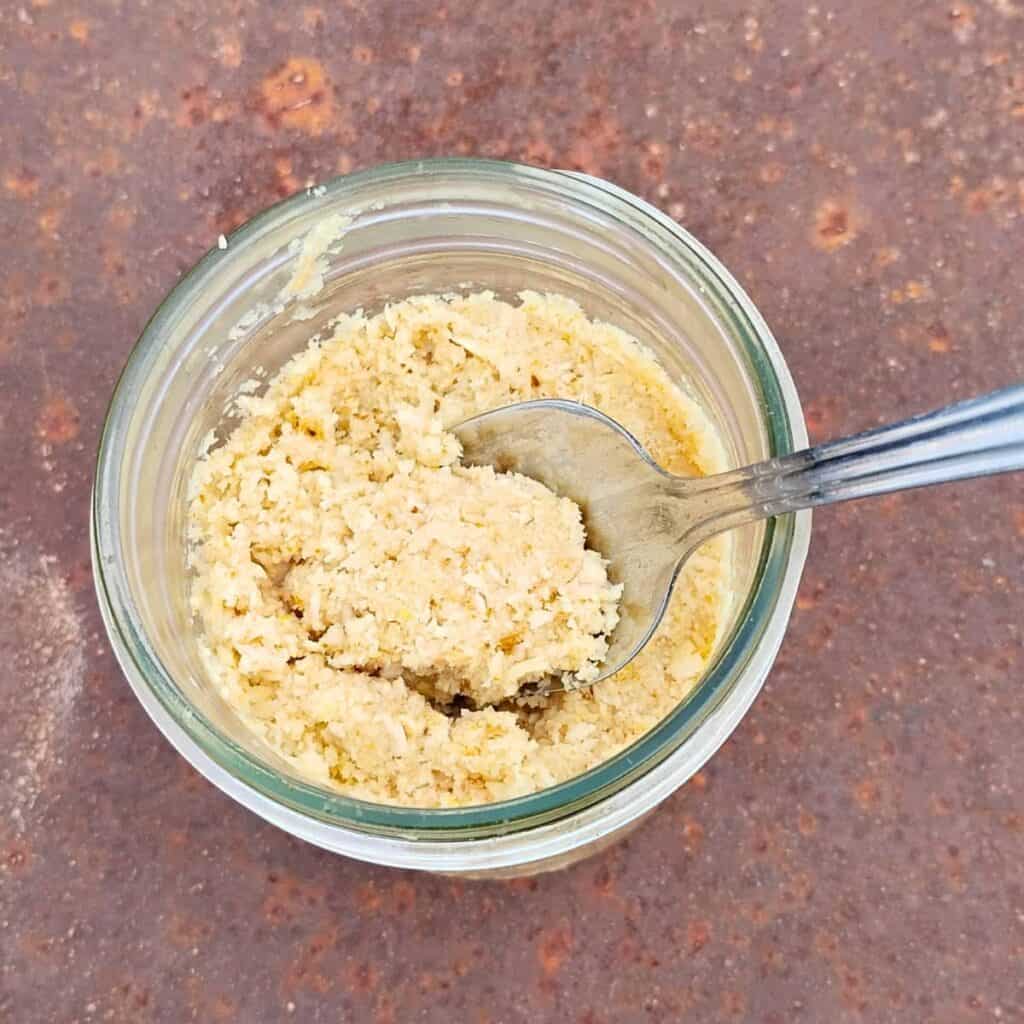
Congratulations! You’ve got a nice jar of horseradish root in your fridge! This was so easy and now you can enjoy mess-free horseradish root whenever you need it. And you’ll appreciate the fermented horseradish if you like the health benefits but don’t enjoy the pungency of fresh horseradish. So use it generously and feel good about getting the many benefits of this powerful ally for your health.
What are your favorite uses for horseradish paste? What other ways do you use horseradish? Let me know in the comments below, I’d love to hear about it. And if you have any questions, I’ll be glad to answer them in the comments as well. To your health!
To get more recipes like this and other information on homesteading and traditional skills, sign up for my Food For Life Garden News, and I’ll let you know when I post new information.
More Recipes Like This
Probiotic Ginger Paste – A convenient way to have ginger on hand when you need some, either as seasoning in cooking or baking, or to use this powerful ally in your daily health routine.
Fermented Garlic – Lacto-fermented garlic paste is kind of a special food. It’s the ultimate convenience food and health supplement. But besides that, it gets better as it ages. Just like a fine wine.
Fermented Garlic and Honey – A powerful combination of two all-star infection and sickness fighters. Make this easy remedy today and be ready for cold and flu season!
Fermented Ginger Honey – Keep this potent fermented health food on hand. Use the powers of Ginger and Honey in a tasty syrup form that you’ll love.
Fire Cider Recipe – Get your fire cider recipe and make this tonic to be ready for cold and flu season!
Ginger bug recipe puts exciting fizzy sodas on your table! Meet my friend the ginger bug and learn how to get one started for yourself.
25 Essential Herbs To Plant – Start your home apothecary garden with these 25 powerful allies for your health. Learn their benefits, how to grow them and where to source them.
Fermented Chili Paste – Here is a great way to preserve your end-of-the season harvest of green peppers. This paste will last all year in your refrigerator to use as a condiment, seasoning, or topping.
Black Walnut Tincture – Black walnut has been used as a deworming tincture for a long time. Make your own with my recipe. I like to use it as part of my goat deworming routine with great results so far.
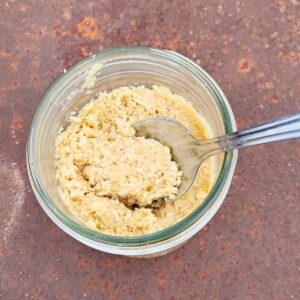
Prepared And Fermented Horseradish And Extract Recipe
Equipment
- A pint jar for fermenting
- Fermentation Lid
- Fermentation weight
- Pickle packer
- Scale
- Blender, Grater or Food Processor
- Wide mouth funnel
Ingredients
Lacto-Fermented Horseradish
- 14 ounces grated horseradish root
- 1½ tsp salt
- 2-4 Tbsp raw apple cider vinegar
For Vinegar Prepared Horseradish
- 14 ounces horseradish root
- ½ tsp Salt
- 1 cup Raw vinegar, approximately
Horse Radish Root Extract
- 10 oz horseradish root
- 100 proof Vodka
Instructions
Lacto-Fermented Horseradish Root
- While peeling improves the texture of horseradish, it's better to leave it on when you ferment it. We want the nutrients in the skin and the beneficial bacteria that grows naturally on the skin for a better fermentation. If you want to peel yours, It's best to add a quarter cup of starter culture. This can be the juice from a previous ferment or whey from cheesemaking.
- Grate your horseradish on the fine side of your grater. Or you can roughly chop the horseradish and use a food processor to chop it. I advise doing so outside where the fumes won't irritate your sinuses or eyes.
- Now calculate your salt. You'll be using 2% of the weight of the horseradish in salt. If your horseradish weighs 400 grams, this is your formula: 400 x .02 = 8. You'll be adding 8 grams of salt. If you don't have a scale, add 1½ tsp of salt per pint of horseradish.
- Give the paste another whirl in your processor or stir well to incorporate the salt.
- Using a funnel, transfer your ingredients into the fermentation jar.
- With your pickle packer, a spoon, or your fist, press the ingredients firmly into the jar to eliminate air bubbles and to submerge the ingredients in the brine. If you don't have enough brine to cover the horseradish, add a little water.
- Push down the ingredients with a fermentation weight and make sure they are submerged below the surface.
- Seal with a fermentation lid or a canning jar lid.
- Place a plate under it and leave it for 1- 3 weeks in a darkish corner at about 70-80℉. 3 weeks is the recommended time for long fermentation. But it will be pretty good after a week.
- Maintenance and Observing – Just keep a casual eye on your fermentation. You don't need to do anything if it looks ok. It will start to bubble and possibly ooze out of the jar. That is a good sign.
- Important: If you're using a regular mason jar lid, don't forget to burp it every day.
- Now you can open it, look at it, smell it. If nothing seems off, taste some. If it's good, and you want to store it at this point, take out the weight and add the two tablespoons of vinegar or enough to keep the horseradish covered.
- Top with a regular lid and place into the refrigerator. There it will keep for a year. You can also let it ferment for another 2 weeks for the full fermentation benefits.
Vinegar Prepared Horseradish
- This prepared horseradish will also be probiotic if you use my method, but the probiotics will come from the raw vinegar instead. In this preparation you can peel the horseradish because we don't rely on the bacteria that is on it to help with the ferment.01. Prepare the horseradish by washing and if you prefer, peel it. Then grate or process it in a food processor. 02. Let the horseradish stand for about 5 minutes to develop it's pungency before proceeding.03. Mix well with the salt, add the horseradish to the pint jar and pour vinegar over it to cover. I like to keep it out at room temperature for a few days, and then I put it into the refrigerator, where it keeps for several months. You can use this immediately after making it. The pungency will decline over time, but it will still be a tasty spice to add to your favorite dishes.
Horseradish Extract, Alcohol Based
- If you want some horseradish on hand for relieving sinusitis or a stuffy nose, you can preserve its pungency inside an alcohol based tincture. All you need to do is to fill a jar loosely, half full, with grated or thinly sliced horseradish root. Wait 5 minutes for the pungency to develop and then pour 100 proof vodka over it (80 proof will do in a pinch). Fill the jar to the very top and seal tightly. Shake it every day or two and let it extract for 6 weeks or longer. Now strain out the herb, using a butter muslin or cotton cloth. Squeeze out as much liquid as you can. Cap tightly and store for when you need it. I can't recommend a dosage, but I take about 6 drops every one or two hours at the onset or during the acute stage, then I taper off the frequency to 2-3 times a day, until the allergy or sinus infection subsides. It acts fastest when dropped straight up under the tongue, but it can also be mixed into water or juice. You can add this extract to salad dressings, smoothies and vinegars, or anywhere you would like the pungent flavor of horseradish.
Notes
How To Use Prepared Or Fermented Horseradish Root
You can treat this paste as a seasoning for any dishes that you like to spice up a little. But here are a few ideas for specific uses: Make a Cocktail Shrimp sauce Use it to flavor a Bloody or Virgin Mary Replace your unhealthy toppings with this healthy one in burgers, sandwiches, BBQ meats, etc. Use it in a creamy sauce made with sour cream, mayonnaise, or cream cheese as a condiment to your prime rib, lamb roasts or fish. Top your baked potato with it. Add it to potato salad, macaroni salad, egg salad, grated carrot and celery root salad, and deviled eggs. Add it to your hummus or stir into mayo for a dressing, topping or sandwich spread.Final Thoughts
Congratulations! You’ve got a nice jar of prepared horseradish root in your fridge! This was so easy and now you can enjoy mess free horseradish root whenever you need it. So use it generously and enjoy the many benefits of this powerful ally for your health.Pin for later!
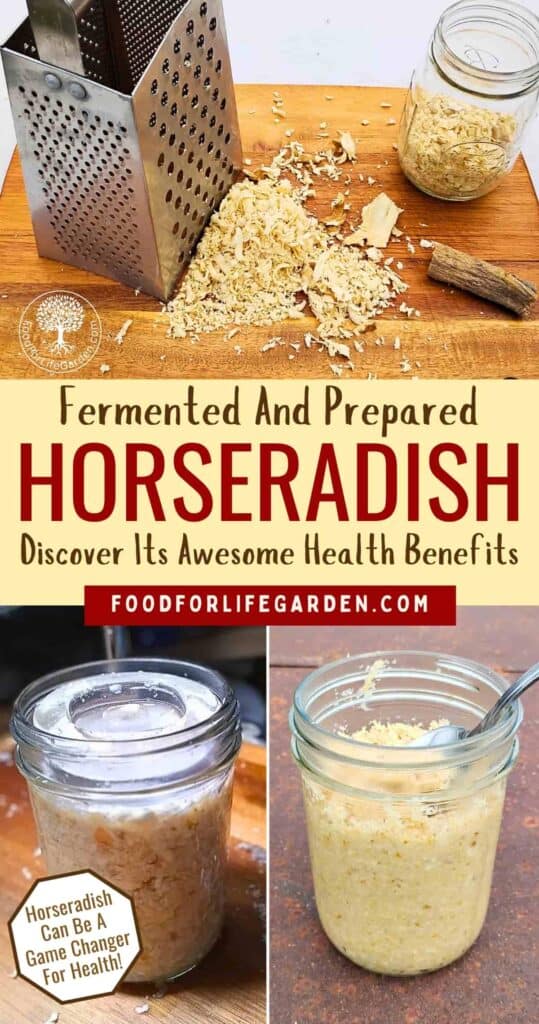
Shop This Post
Wide mouth funnel
Blender
Vitamix
Manual chopper
Electric food processor
Scale
Fermentation tops
Airlocks with metal lids
Airlocks with plastic lids
Redmond’s Real Salt
Himalayan pink salt
Celtic sea salt
Bormioli Fido Jar
Glass weights
Ceramic weights
Acacia wood tamper
Dropper bottles
Azure Standard – get organic ingredients here

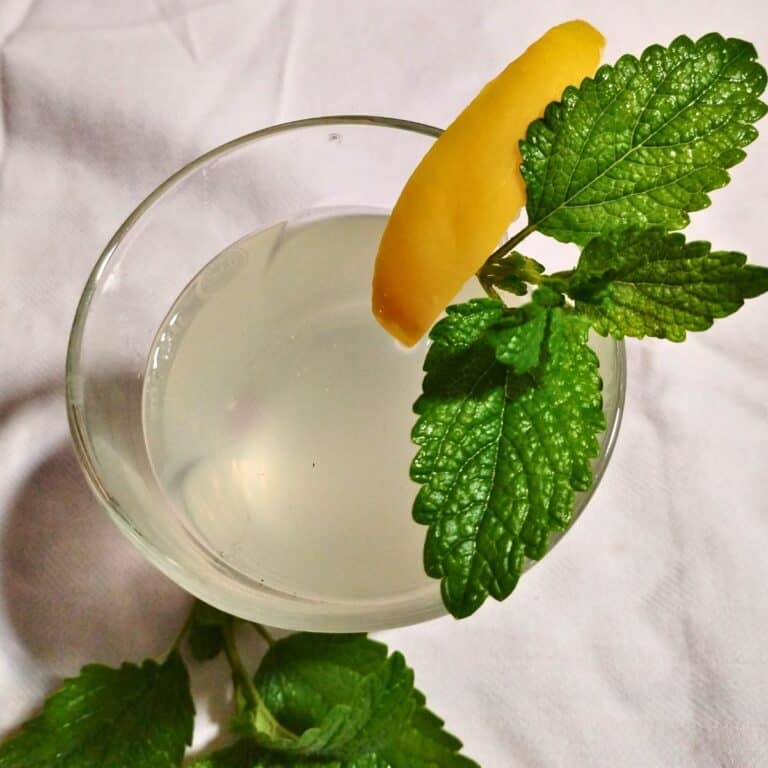


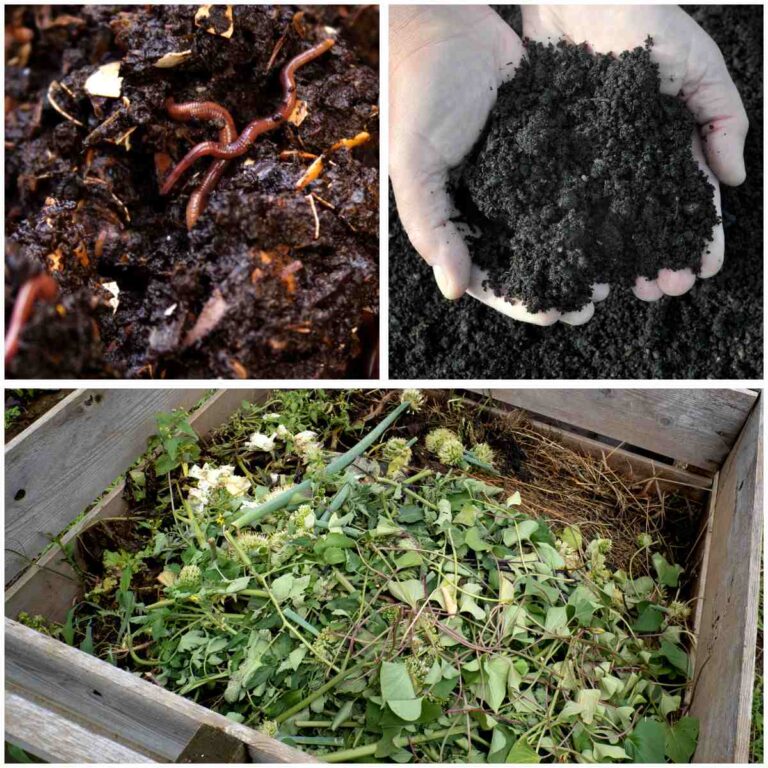


I’ve never heard of fermented horseradish before, but I’m wanting to try fermenting more veggies. Thank you for sharing! Saving this idea!
Thanks so much commenting. I hope you get to try it!
No way, fermented horseradish is on my schedule to be making soon! Nothing clears your sinuses like horseradish, haha.
That’s so true! You might also like the horseradish extract for that purpose! It’s potent.
I use horseradish in my fire cider recipe. I had no idea all of the amazing health properties or that you could ferment it. Thank you for the info!
You’re welcome, Kelly! I think horseradish is just recently getting more attention. It deserves it!